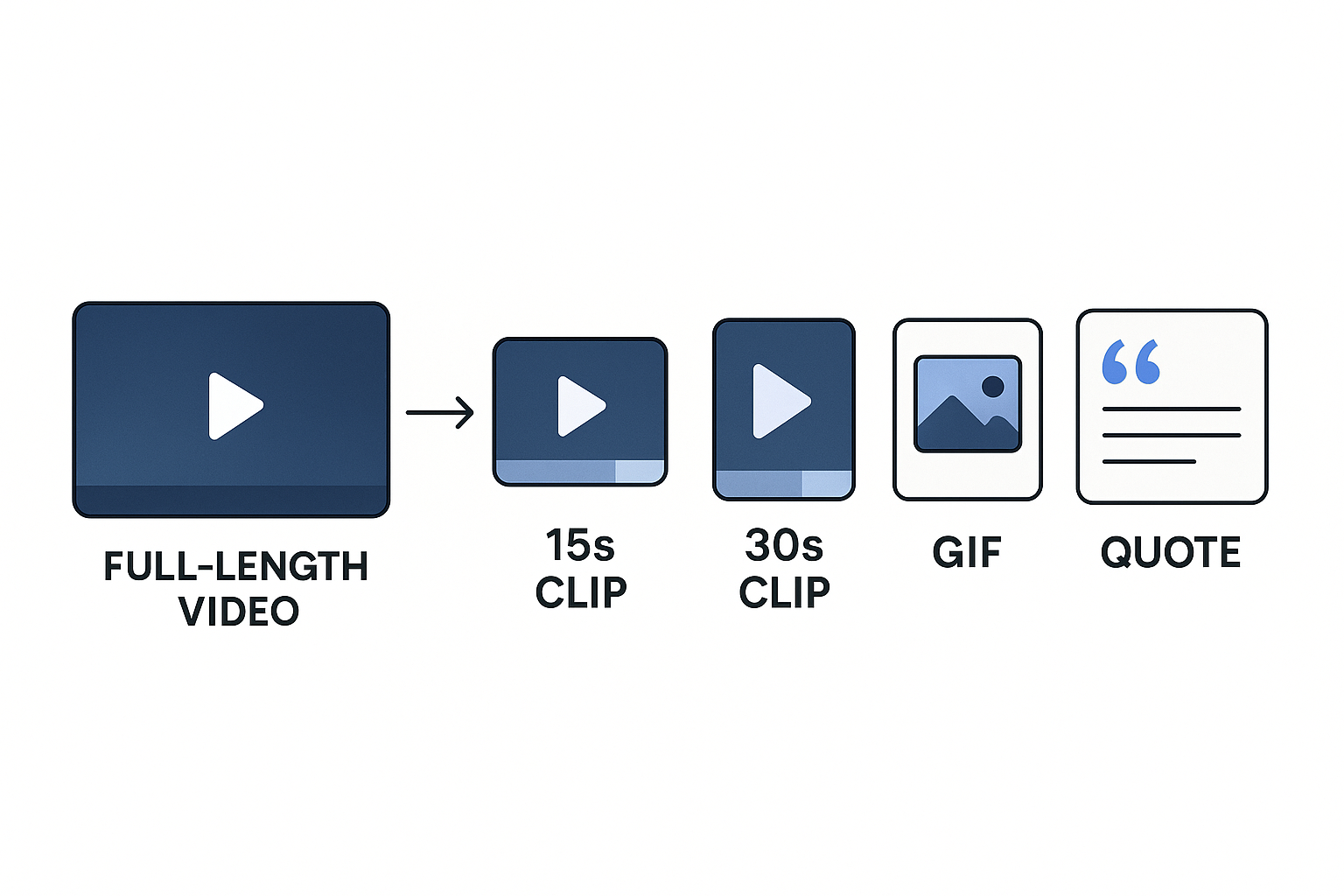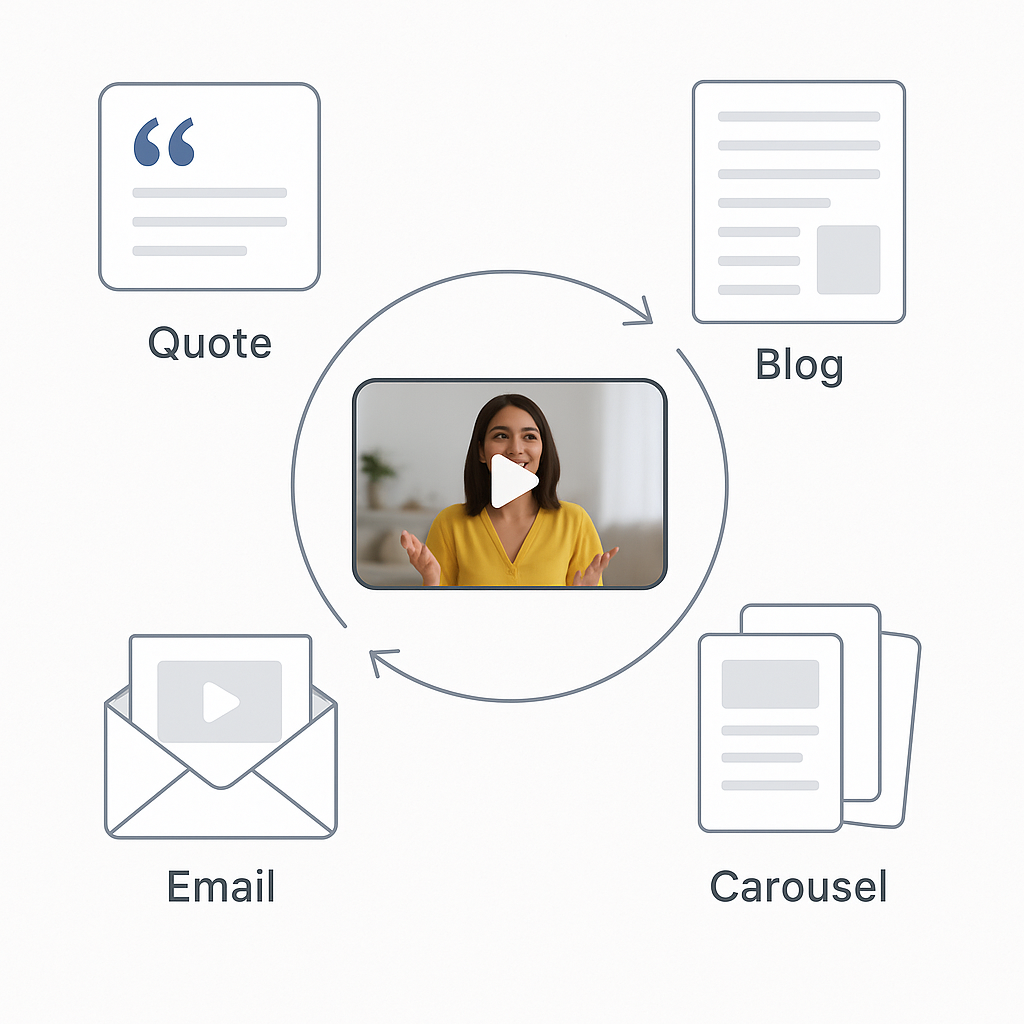Creating a great video takes effort. You spend time scripting, shooting, editing, and perfecting it. So why use it just once?
If you're not repurposing your video content across multiple channels, you’re leaving reach, revenue, and performance on the table. Let’s explore how to stretch one video into an entire campaign system — for both paid and organic.
1. Start With a Core Video That Converts
Before you can slice and dice a video into multiple assets, you need a strong base. Think of it like baking a cake before you cut it into slices for different guests.

Your original video should be built around a single, strong idea. Before you repurpose, make sure the base content checks a few boxes:
-
It opens with a hook. The first 3 seconds need to stop the scroll, especially for social platforms like Meta and TikTok.
-
It works without sound. Add subtitles and use expressive visuals.
-
It’s optimized for attention. Cut the fluff and get straight to the value.
-
It speaks to one audience. You can later adapt it, but start with a clear target.
If you’re unsure what video format works best on each platform, this guide to Facebook ad formats can help.
2. Cut It Into Micro-Assets
Once your base video is solid, it’s time to think like an editor. Imagine you’re turning a movie into trailers, teasers, behind-the-scenes clips, and bonus content.
One long-form video can easily become dozens of short clips, teasers, and GIFs. Here’s how to break it down:
-
Teasers (5–20 seconds): Grab attention with curiosity, drama, or a bold claim. These are ideal for Reels, Story ads, or as scroll-stoppers in the feed.
-
Feature-focused snippets (20–40 seconds): Highlight one feature, benefit, or testimonial at a time. This format works well for the middle of your funnel.
-
Gifs or loops: Turn short, punchy moments into motion graphics for email, remarketing ads, or social posts.
-
B-roll clips: Extract visually appealing segments to use as background footage behind text, voiceovers, or quotes.
Want help automating this? Tools from the best AI content generators can speed things up.
3. Adapt for Platform + Funnel Stage
Now comes the strategic part: repackaging content in a way that feels natural to each platform and context. Repurposing doesn’t mean copy-pasting — it means tailoring with intention.
What to adapt:
-
Format: Use 1:1 for Facebook Feed, 9:16 for Stories and TikTok, and 16:9 for YouTube. This ensures your videos display correctly and capture full attention.
-
Tone: Adjust the intro to match the platform vibe. What works on TikTok might not land the same on LinkedIn.
-
Call to action: Align the CTA with the funnel stage. Awareness videos should spark curiosity, while retargeting clips should prompt clicks.
-
Thumbnails: Choose an eye-catching frame to serve as the thumbnail, especially on YouTube, where it can affect click-through rate.
Want a deeper look at funnel-based structuring? Read our Facebook funnel strategy guide.
4. Mix Video With Static + Text Formats
Repurposing doesn’t stop at video. You can extract a ton of additional assets from your visuals and script.

You can also extract static and text-based assets from the original video to power up your full content mix:
-
Quote graphics: Turn standout phrases into branded visuals for Instagram, Stories, or carousel ads.
-
Blog posts: Use the video script or transcript as a jumping-off point for a written article (like this one).
-
Carousel slides: Break down 3–5 main points into slides that encourage swiping and engagement.
-
Email content: Add short gifs from the video or link to the full version in your nurture sequences.
This makes your creative more versatile and extends the lifecycle of your messaging. For more on this hybrid strategy, see how to repurpose a single creative into five Facebook formats.
5. Refresh and Reuse High-Performing Videos
Just because a video is "old" doesn’t mean it’s irrelevant. You can revive great performers with minor tweaks.
Here are smart ways to update and reuse your winning content:
-
Change the hook or intro line. A new opening can change how the whole video is perceived.
-
Swap out music or transitions. These small edits can tailor the vibe to match different platforms or campaigns.
-
Update the offer or CTA. Keeping calls to action timely ensures relevance to your goals.
-
Use it in new placements. If it worked on one platform, test it on another. You might be surprised.
Beyond these tactical tweaks, consider remixing older content to align with seasonal trends or current campaigns. A product testimonial that worked in summer can be re-edited with a new headline and offer for Q4.
You can also integrate these refreshed clips into retargeting ads, onboarding emails, or evergreen content funnels. The creative is already validated — now it's about maximizing mileage across more touchpoints.
6. Build a Creative Bank You Can Pull From
As your library grows, you can build a creative bank — a central hub where your team can quickly grab assets for new campaigns. This helps speed up turnaround and avoid starting from scratch every time.
The ultimate goal? Have a library of reusable, remixable assets. This lets you:
-
Reduce production costs. No need to reshoot every campaign.
-
Test new concepts faster. Use variations to validate different hooks or offers.
-
Scale without burning out your audience. Fresh cuts of proven content keep things interesting.
Segment videos in your bank by format, funnel stage, platform, and message type. And don’t forget to track performance — some "evergreen" assets perform better six months after their first run.
Final Takeaway
Every video you make has more potential than you think. Repurposing isn’t a lazy shortcut — it’s a smarter, more strategic way to get ROI from your content.
Need to keep performance strong across changing campaigns? Build once, repurpose often, and deliver consistently.

